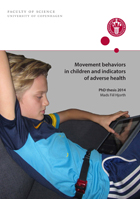PhD defence: Movement behaviors in children and indicators of adverse health
Mads Fiil Hjorth
PhD thesis
The prevalence of overweight children is high and increasing numbers of children now show features of metabolic syndrome. Various aspects of physical activity, sedentary behavior, and lack of good-quality sleep have all been linked to this recent development of overweight and cardio-metabolic risk among children. Early puberty is a period characterized by rapid changes in body composition and movement behaviors. As movement behaviors, obesity, and cardio-metabolic risk appear to track from childhood to adulthood, this may be a critical period for implementing preventive strategies aimed at reducing obesity and its associated metabolic complications in adulthood.
In my PhD thesis I assessed objectively measured physical activity, sedentary behavior, and sleep in 8- to 11-year-old Danish children and related these movement behaviors to indicators of adverse health (dietary intake, adiposity, and cardio-metabolic risk markers).
Firstly, findings indicated that waist-worn accelerometers could be used to obtain a proxy measure of sleep duration meaning that monitoring of physical activity and sleep could be done by a single accelerometer worn on the waist for 24-hours a day.
Secondly, most of the children did not meet international screen time, physical activity, and sleep recommendations. Physical activity was lower and sedentary time was higher during winter and during weekends and sleep duration was also lowest during weekends indicating that these periods might serve as key intervention periods to promote a healthy lifestyle.
Thirdly, short sleep duration and a high variability in sleep duration, as well as sleep problems, were associated with an obesity-promoting diet. Short sleep duration was also associated with a higher fat mass index and increased cardio-metabolic risk. Furthermore, a decline in physical activity was associated with increased fat mass index and cardio-metabolic risk over a 200-day follow-up period. Results indicated that low physical activity and high sedentary time was the result of fatness rather than its cause. Finally, combined negative levels of physical activity, sedentary behavior and sleep were synergistically associated with higher fat mass index and cardio-metabolic risk.
In summary, these results suggest that multiple movement behaviors should be targeted to improve cardio-metabolic risk markers in childhood and that this is possibly mediated or confounded by adiposity.
2014, 146 pages,
ISBN 978 87 7611 723 8
Time
31 March 2014 at 13:00
Venue
Festauditoriet, 1-01, Bülowsvej 17, 1870 Frederiksberg C
Opponents
Associate Professor Christian Mølgaard (Chair), Department of Nutrition, Exercise and Sports Faculty of Science, University of Copenhagen, Denmark.
Professor Ulf Ekelund, Department of Sports Medicine, Norwegian School of Sports Science.
Professor Lars Bo Andersen Institute of Sports Science and Clinical Biomrchaincs, Research in Childhood Health, University of Southern, Denmark.
Supervisors
Associate Professor Anders M Sjødin, Department of Nutrition, Exercise and Sports, Faculty of Science, University of Copenhagen, Denmark.
Kim Fleischer Michaelsen, Department of Nutrition, Exercise and Sports, Faculty of Science, University of Copenhagen, Denmark.
Professor Inge Tetens, National Food Institute, Division of Nutrition, Technical University of Denmark.

